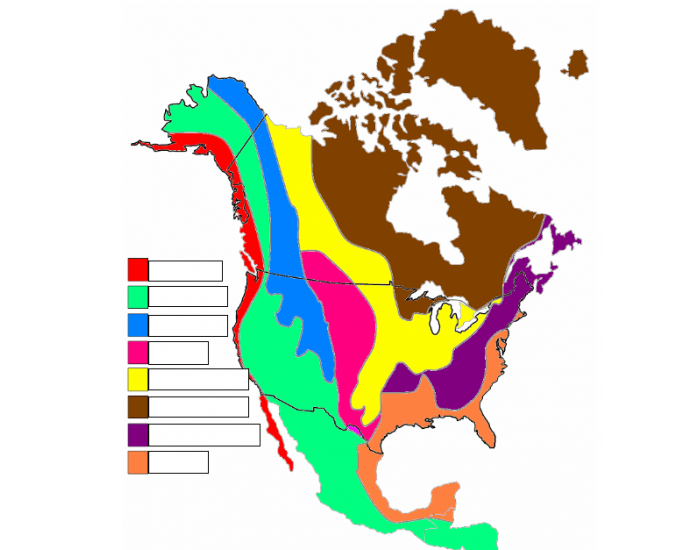The geographical regions of North America present a rich tapestry of landscapes, cultures, and ecosystems that significantly contribute to the continent’s identity. Stretching from the polar realms of the Arctic to the tropical expanses of Mexico, this diverse geography invites an exploration of its various segments. North America can broadly be partitioned into five distinct regions: Canada, the United States, Mexico, the Caribbean, and Central America. Each area embodies unique attributes that collectively shape not only the environmental dynamics but also the cultural and socio-economic undertones of the continent.
Beginning with Canada, the second-largest country globally, it embodies a vast expanse of tundra, boreal forests, and mountainous terrains. The Canadian Shield, a geological formation rich in minerals, curves around the Great Lakes and extends into the Arctic. With natural wonders like the Rocky Mountains, which flank the western provinces, and thousands of lakes and rivers, Canada is a haven for biodiversity. Wildlife such as moose, beavers, and bears thrive in these varied ecosystems. The climate ranges from arctic cold in the north to temperate regions in the south, establishing a distinct interplay between nature and human activity. As climate change unfolds, the implications for Canada’s biodiversity and its indigenous populations are profound, sparking conversations about environmental stewardship and sustainability.
Traveling southward, the United States showcases an astounding variety of terrains. From the arid deserts of the Southwest, including the iconic Sonoran and Mojave deserts, to the lush, temperate rainforests of the Pacific Northwest, the United States offers an array of ecosystems that reflect its vast geographical breadth. The central plains are characterized by the rolling prairies, while the Appalachians rise in grandeur in the eastern part, hinting at ancient geological formations. Each state possesses its unique climate and topography, leading to an astonishing diversity of flora and fauna. The intersections of urbanization and natural conservation efforts continue to create a dynamic dialogue about land use and environmental protection amid the encroachments of industrialization.
Mexico, the third-largest country in North America, is renowned for its dramatic contrasts in geography. Home to arid deserts, tropical rainforests, and towering mountain ranges like the Sierra Madre, Mexico’s landscapes provide a variety of habitats. The Yucatán Peninsula, known for its limestone caves and cenotes, contrasts sharply with the Sierra Tarahumara, where indigenous cultures have flourished for centuries. Mexico’s environmental challenges are undeniably complex, facing issues such as deforestation, water scarcity, and pollution. Yet, this region also holds rich ecosystems, notably in its coral reefs along the Caribbean coast, which require preservation amidst climate variability and human impact.
The Caribbean region, often seen as a paradise of sun-soaked beaches and crystal-clear waters, offers an intricate archipelago that comprises over 7,000 islands. This region experiences a tropical climate, contributing to its vibrant biodiversity. The unique ecosystems range from mangroves to coral reefs, providing crucial habitats for myriad species. The environmental history of the Caribbean is punctuated by the effects of climate change, including rising sea levels and increasingly severe storms, which pose existential threats to its island nations. As these communities grapple with the realities of climate adaptation, they are also at the forefront of sustainable tourism initiatives that seek to balance economic imperatives with ecological preservation.
Central America, a narrow isthmus connecting North and South America, is home to a myriad of geographic and cultural wonders. This region is characterized by volcanic mountains, lush rainforests, and diverse wildlife. The isthmian landform profoundly impacts climate and weather patterns, creating distinct microclimates. Central America’s rainforests, notably in countries like Costa Rica and Panama, serve as biodiversity hotspots, harboring countless species of flora and fauna, many of which are endemic. Environmental issues such as deforestation and agricultural expansion increasingly threaten these vital ecosystems. Conservation efforts are paramount in addressing these challenges, fostering a sense of interdependence among communities and their natural surroundings.
As one examines the geographical regions of North America, it becomes evident that the intricate relationships between humans and their environment are pivotal in shaping the region’s future. The pressing challenges of climate change reinforce the necessity for innovative solutions and sustainable practices across the continent. Migration patterns, shifts in biodiversity, and changing agricultural zones directly correlate with the environmental transformations influenced by human activity. Communities are now prompted to engage in dialogues about resilience, adaptation, and the role they play in preserving their unique environments.
Furthermore, the rich cultural tapestry woven by the diverse populations inhabiting these regions accentuates the interplay between geography and identity. Indigenous heritage and traditional ecological knowledge offer valuable insights into sustainable practices. By integrating these perspectives with modern science and technology, there exists a promising opportunity to foster a renewed respect for nature and a commitment to environmental stewardship. Through collaboration and empathy, the inhabitants of North America can cultivate a sustainable relationship with their geographical gift—a relationship that honors the past while innovatively addressing the needs of the future.
In conclusion, the geographical regions of North America are not mere demarcations on a map; they are vibrant, interlinked ecosystems filled with diverse cultures and histories. Understanding and appreciating these regions—and the environmental issues they face—encourages curiosity and invites a commitment to fostering a sustainable future. The call for action is clear: as stewards of our land, we must champion environmental justice and sustainability to ensure that the natural beauty and cultural richness of North America endure for generations to come.
